- Skip to primary navigation
- Skip to main content
- Skip to primary sidebar

- DIY Home Projects
- Holiday Decorating & Recipes
- Free Email Series
Published: Aug 5, 2021 · Modified: Nov 12, 2024 by Rachel

30+ Homework Station Ideas for Kids and Teens
Ready to make your family’s after-school or home school routine a bit less stressful? An organized homework station is the answer! I’ve included easy tips for small spaces and multiple kids so everyone can have a quiet, supervised space to study.

Table of Contents
It’s back to school time again and along with that comes a flood of emotion. While its sad to see our babies growing up, my inner organizing dork gets a boost of excitement. Create a cheerful space with these homework station ideas to inspire learning, even if you’re short on space!
A homework station is an inviting area that is dedicated to learning, homework, and informal learning like arts and crafts project. Although the kitchen table will suffice for a quick review or a worksheet, we’ve found it’s nice to have a homework zone where school supplies, books, and school calendars can have a dedicated place of their own. This cuts back on clutter and distractions.
I was inspired to write this post because of what I’ve learned from our frustrations with my son’s severe ADHD. At first, homework hour was a stressful experience full of tears (mine), yelling and every possible distraction under the sun. No exaggeration – 20 minutes of homework regularly took almost 2 hours. The material was never the issue. Home school moms, you have my admiration!
That’s where a dedicated space and equitable ground rules saved the day (and my sanity!)
How To Setup a Homework Station
I’ve learned a lot over several incarnations of our homework space. Creating a basic homework station area is simple and effective with these tips below:
- Choose a quiet area. The biggest chance of success is to limit distractions. Preferably with a handy outlet for a laptop, or charging accessories like headphones. For my son, I find that headphones with music (on loop) works wonders.
- Stock it with necessities. My son is the king of wasting time looking for misplaced items. Before official homework time, I ask if he has everything he needs to minimize the chances of him getting up from the desk.
- Set a routine. Same time + Same space = Success. I personally give my son a short break after school before we get down to business.
- Keep ’em close. While we must balance distractions, young children especially need supervision and usually help.
- Minimize your own distractions. When my son was in elementary school, I couldn’t continue working from home during homework time. It wasn’t fair to ask him to stay focused, when I myself wasn’t focused on his questions. So I placed a tiny desk in our kitchen. That way I had both eyes on him while I washed dishes or prepped dinner. I was available, yet still productive.
Homework Station Supplies
Below is a handy list of supplies that are sometimes useful.
- Pens and pencils
- Loose leaf paper for scratch paper or notes
- A timer or clock
- A folder with pockets
- 1 box of color pencils or crayons
- Computer and charger
- A planner (checklists are the lifeblood of this house!)
- Craft supplies as necessary – glue sticks and scissors are examples
- A comfy chair
Homework Station Setup Ideas
Finding the right space is often the most challenging part! I’ve included some inspirational ideas below to get focused. You don’t need to have an elaborate space, but these are great jumping off points to inspire your creativity.
Nooks & Crannies
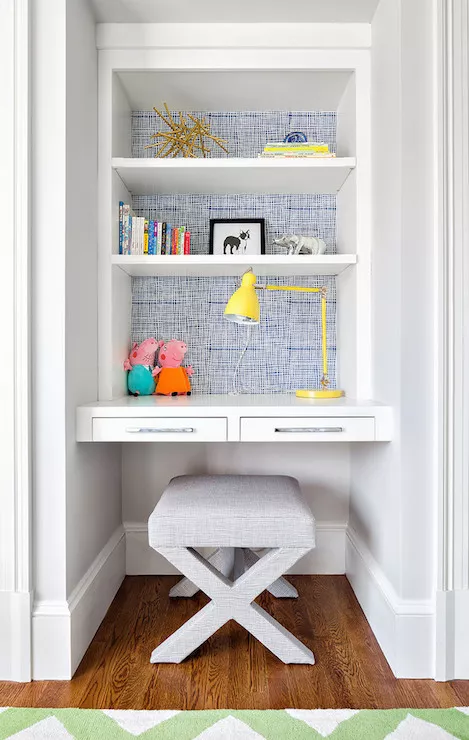
While most of us don’t have room for a dedicated office, there’s usually space to spare like under the staircase, an unused closet, or an awkward alcove . These centrally located spaces are often quiet and can be quite magical.
A small closet can be transformed into a useful desk space. Source: This Old House.
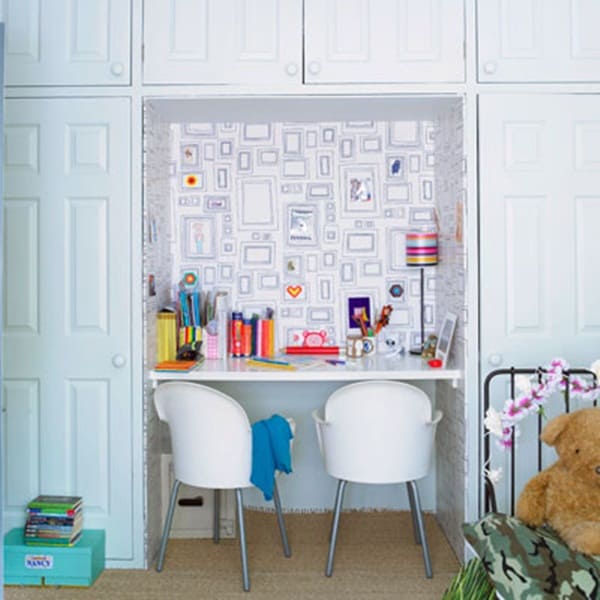
The unused space underneath a staircase like this desk is also perfect for using as a small homework station. This design utilizes fun lines and strokes to make it visually interesting.
Homework Stations that Foster Creativity
I honestly believe that adding a little creativity to the space fosters the desire to learn and leads to great ideas. Classrooms are full of stimulating decorations for a reason.
Here’s a few creative concepts to enhance your learning environment:
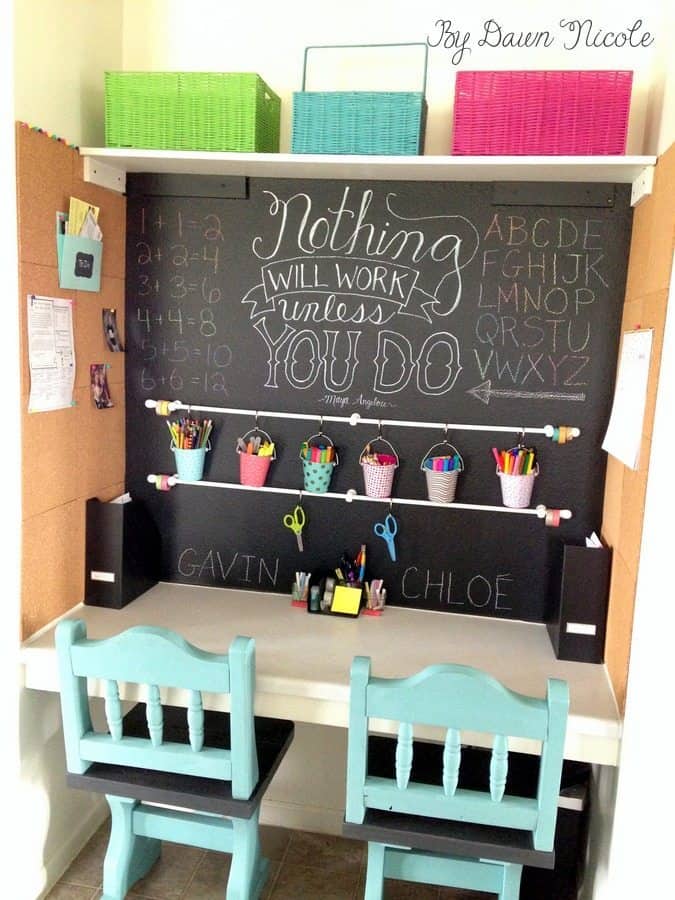
Inspirational quotes on a paintable chalkboard from Dawn Nicole add a touch of whimsy and keep students motivated during tough assignments.
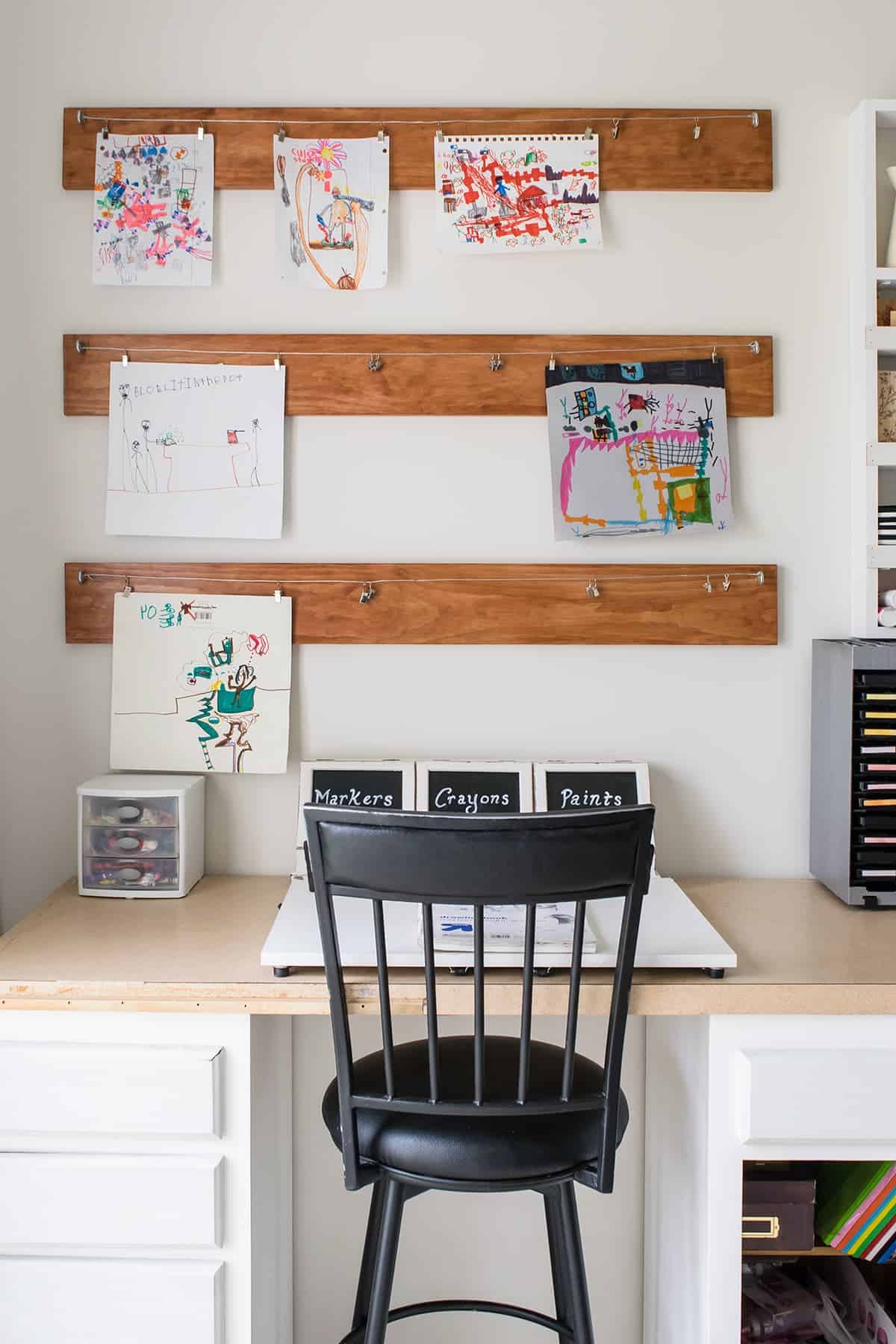
A simple wall Children’s art display like the desk above allows kids to hang their accomplishments and past artwork.

Add a splash of color or maybe some wall flash cards. This colorful playroom would be a joy for kids to work in and gives them lots of space for different kinds of learning.
While these beautiful spaces are awesome, sometimes we just need a simple option like this portable homework station .
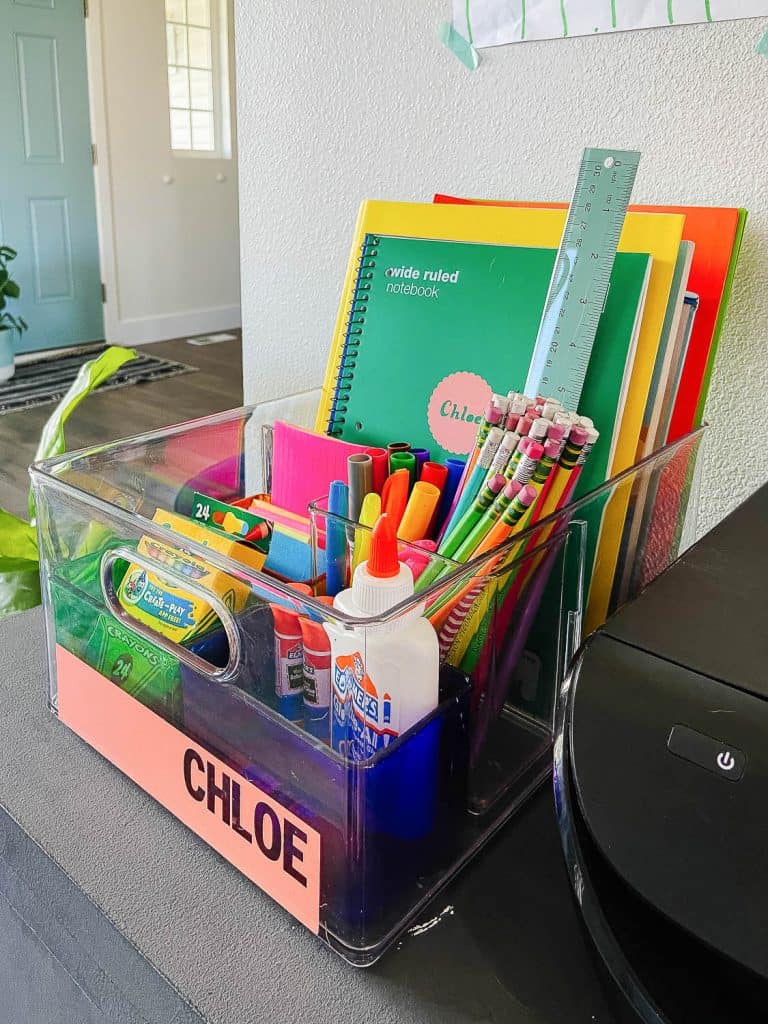
More portable homework station ideas :
- Use a bath caddy to hold supplies so you can grab and go.
- A tiny desk and rolling cart makes it easy to move supplies where you need them, when you need them.
- I love my car seat organizer for homework on-the-go. It’s a lifesaver when I have to run errands.
- This fold away desk vault in a box is brilliant!
Room for Two (or more)
If you have more than one child, figure out how they learn best. Do they prefer to study together? Try setting up the desk so it can accommodate everyone. A collaborative study area is less isolating.
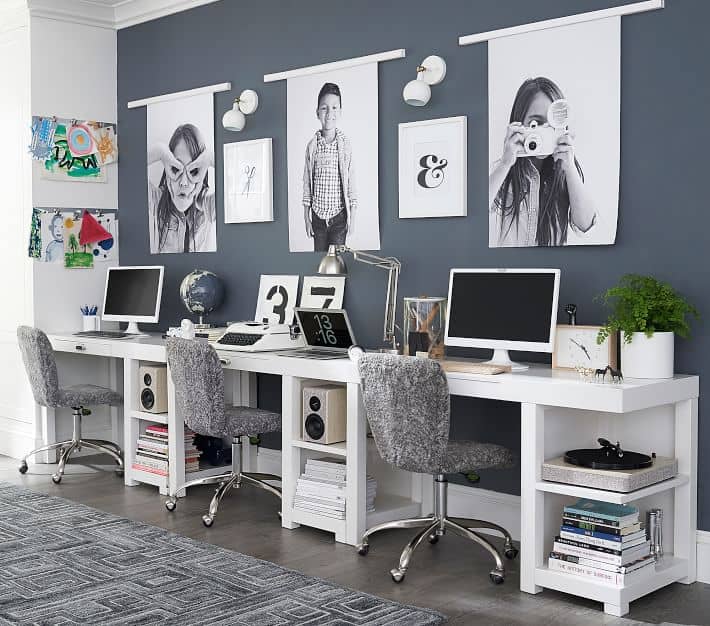
I’m a big fan of this option . Everyone has dedicated space and no one is encroaching on the other’s turf.

This desk utilizes a stacking bookshelf to create two separate work areas and provide ample storage for each user. To save space, you could also have the desks face each other with the bookshelf between them.
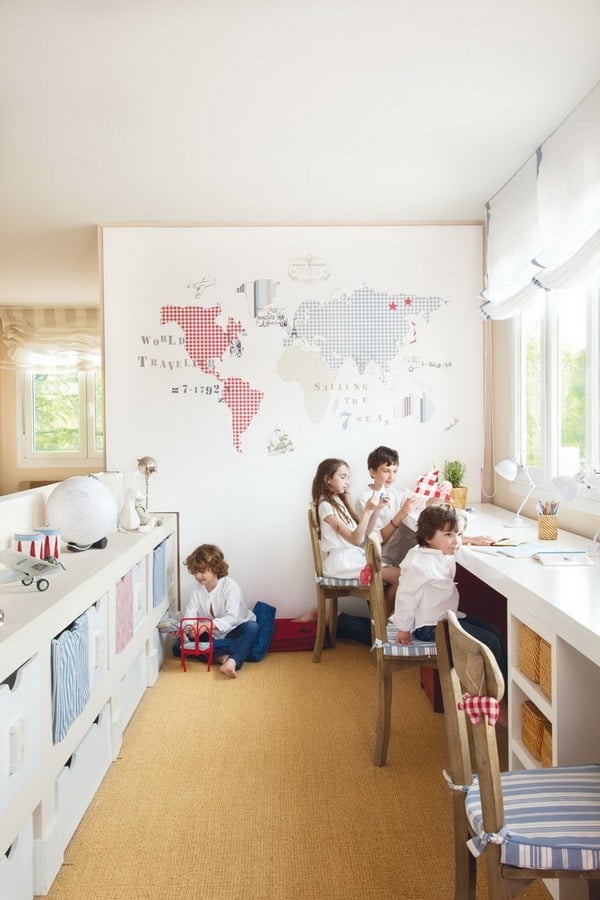
This study zone melds learning and fun. It’s an especially fantastic space for large families. The multi-functional area can accommodate everything from homework, to art projects, and amazing Lego builds.
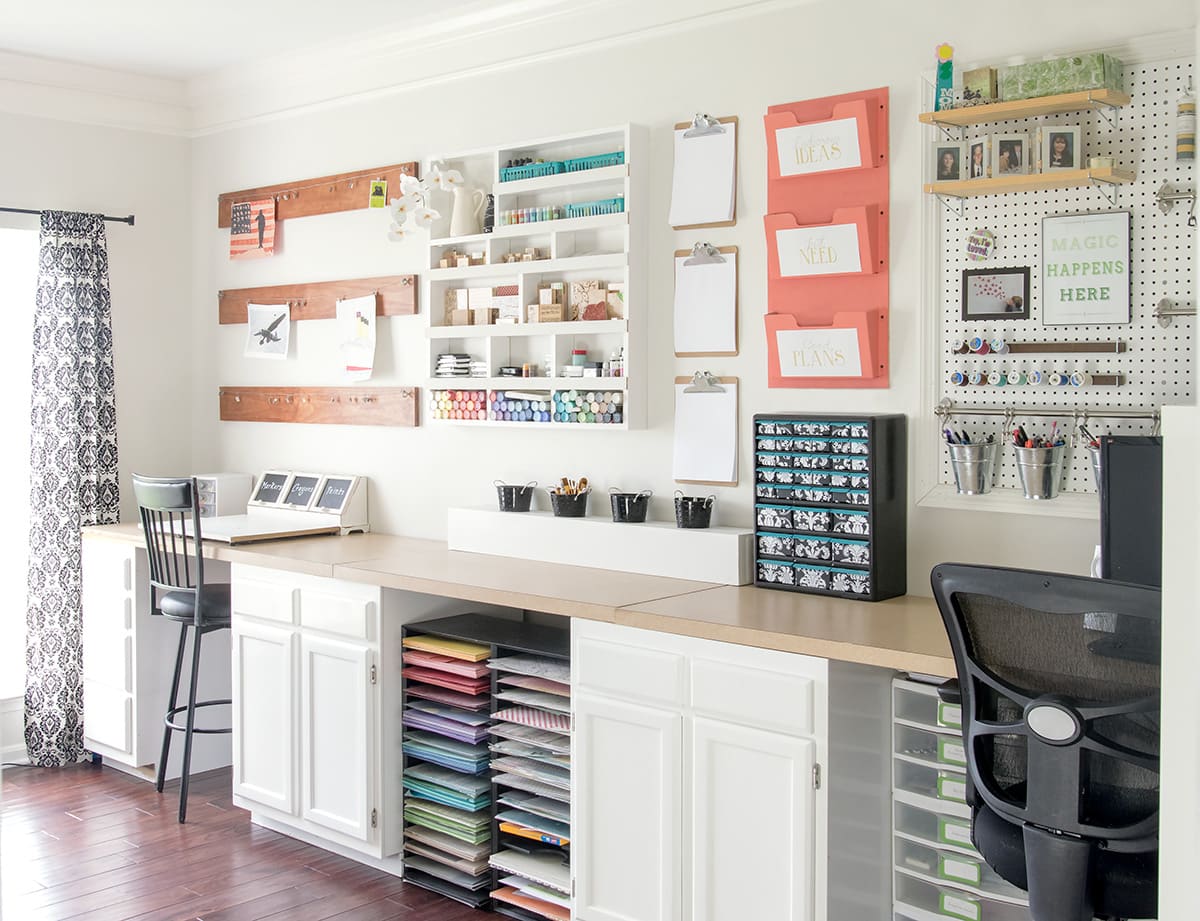
During my own work hours, I share a space with my son. Our craft room makeover project had to include key elements like tandem workspaces, ample organization elements and creative ways to display our greatest hits!
PRO TIP: Peg Boards are excellent additions to any Homework Station. They allow you to customize your storage and wall display without limits. Here’s how we built a DIY pegboard organizer.
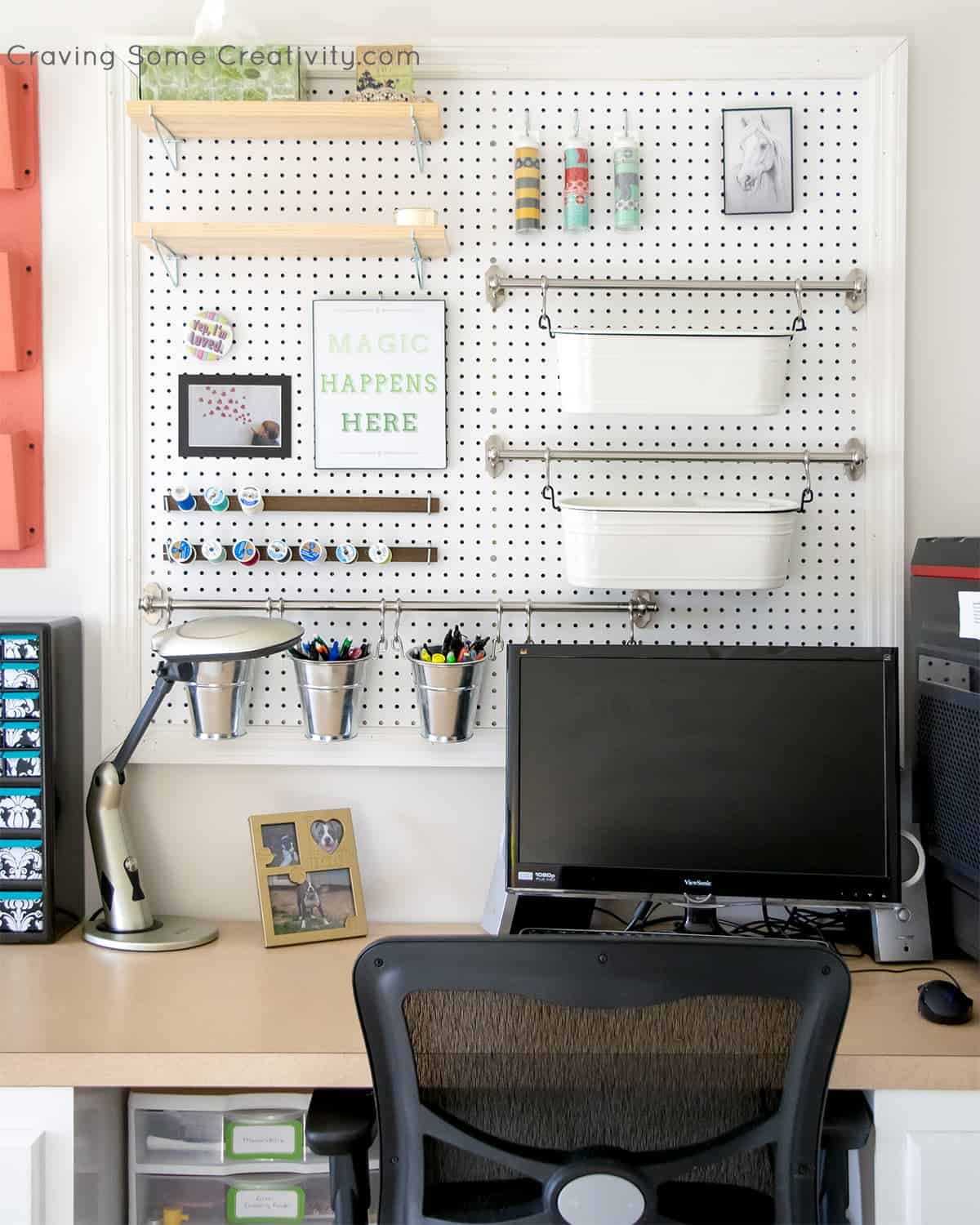
Space Saving Solutions
House a homework nook in even the tiniest space. These space saving desks are brilliant!
Wall Mounted Desk
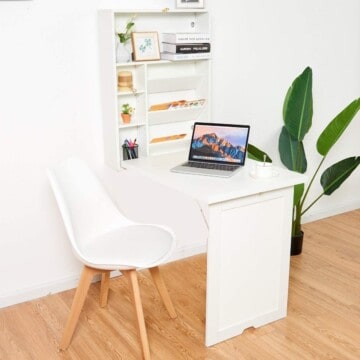
Ladder Shelf
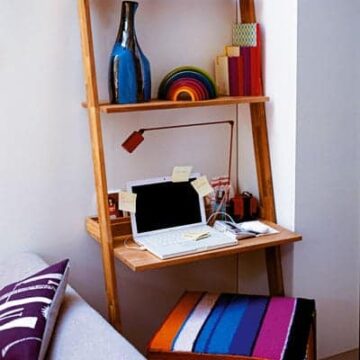
Wall mounted
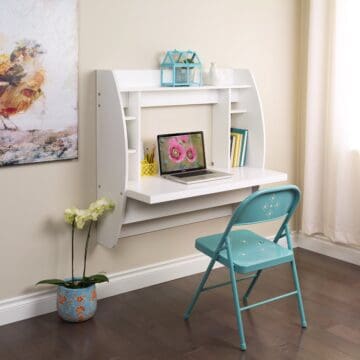
Space Saving Shelf Desk
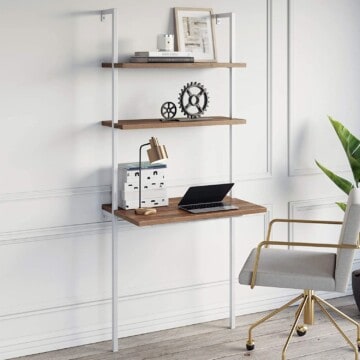
Do you have a dedicated studying area in your home? What’s your top tip for handling the daily homework assignments?
More Ideas You May Enjoy
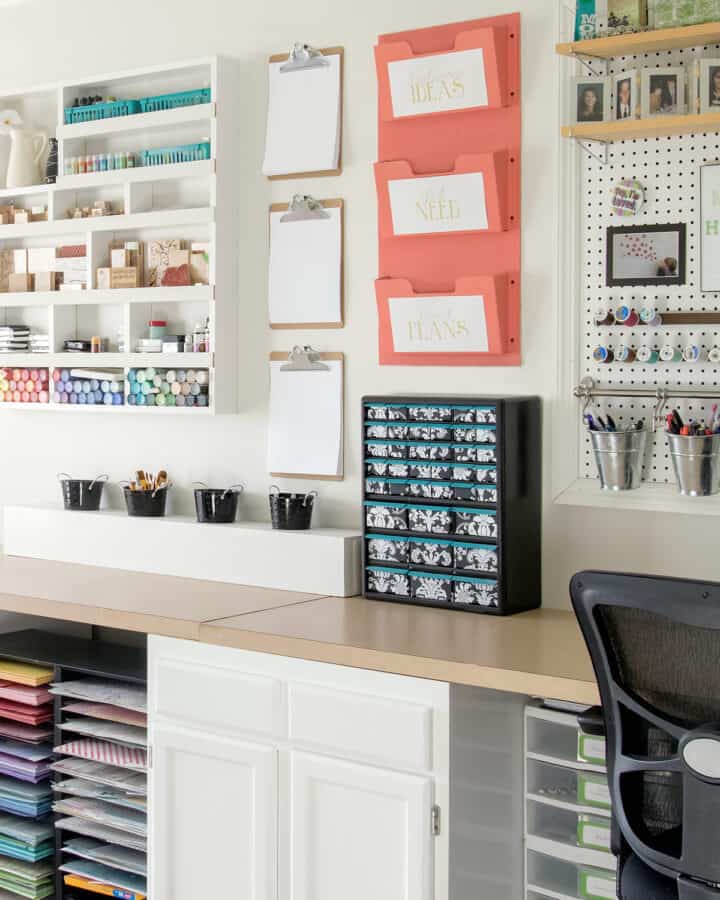
PS I love seeing your creations! Be sure to take a photo and tag #cravingcreative on Instagram ! You can also stay in touch with me through following me on Instagram , Pinterest , and subscribing to the newsletter!
Reader Interactions
Leave a reply cancel reply.
Your email address will not be published. Required fields are marked *
Notify me of followup comments via e-mail. You can also subscribe without commenting.
August 31, 2015 at 11:36 pm
Meredith @ The Palette Muse says
August 31, 2015 at 10:42 pm
- Join Insider
27 Inspirational Homework Areas and Study Stations
Steal ideas from these amazing home office spaces and watch the good grades roll in this semester.
A dedicated space for homework and studying can improve a child’s focus and productivity. Whether you have a large home or a compact apartment, there numerous ways to design an inspiring homework area.
To help you design your own space, we’ll explore 27 creative and functional study station ideas for a variety of needs and spaces.
1. Adjacent Homework Station
Setting up a homework station adjacent to the kitchen allows for independent work while keeping kids close enough for supervision or assistance when needed. The proximity to the kitchen also provides easy access to snacks, fueling those long study sessions.
A bright and lively space can stimulate creativity and encourage learning. To create an inviting atmosphere, opt for vibrant colors like the cheerful yellow cabinets shown here.
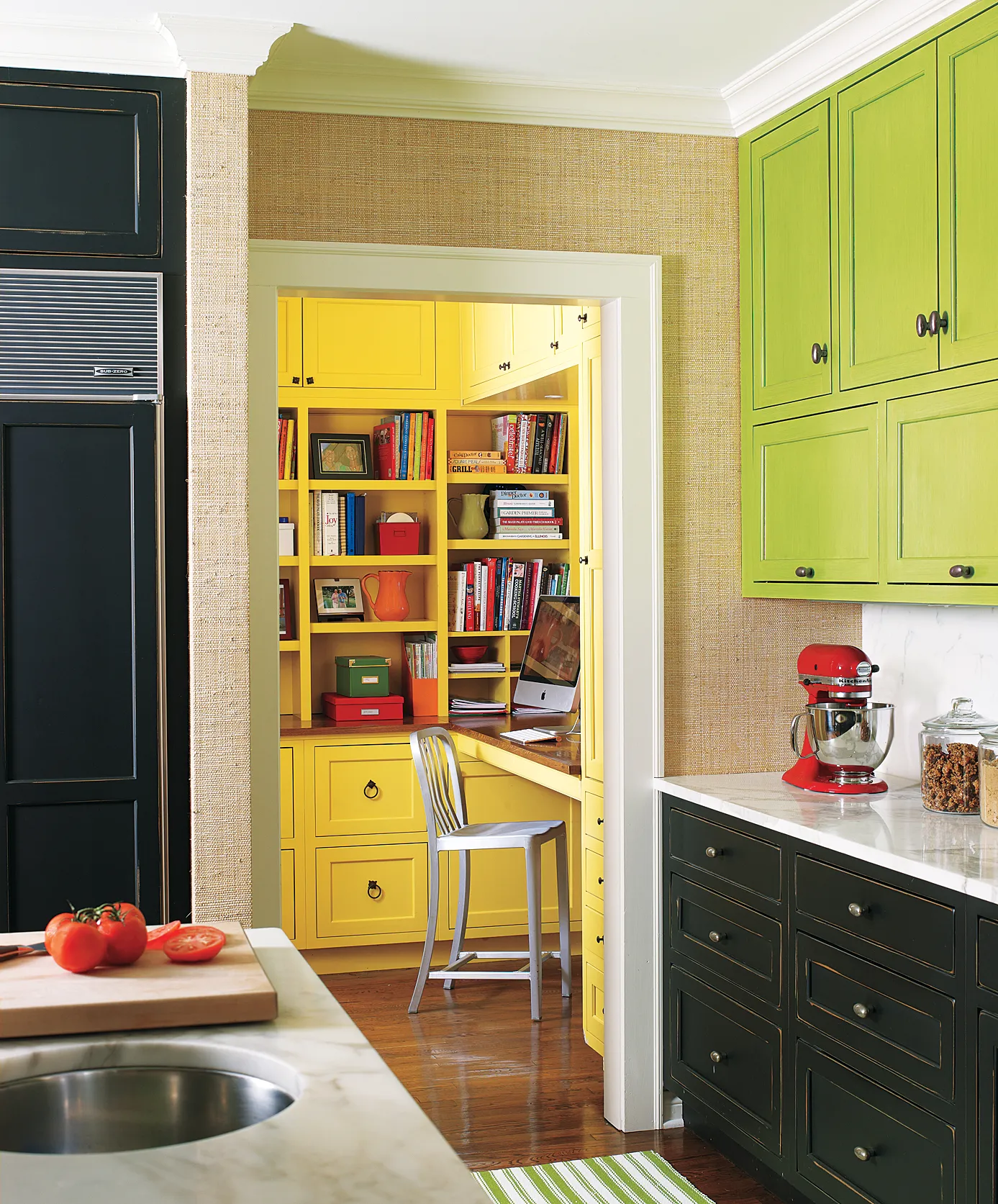
2. Storage-Loaded Homework Alcove
A built-in homework alcove can be great in kids’ rooms. Use stock lumber, storage bins, and sliding tracks to create a compact yet functional workspace. This design not only provides ample storage for school supplies and books but also allows for a retractable work surface, making it ideal for rooms where space is limited.
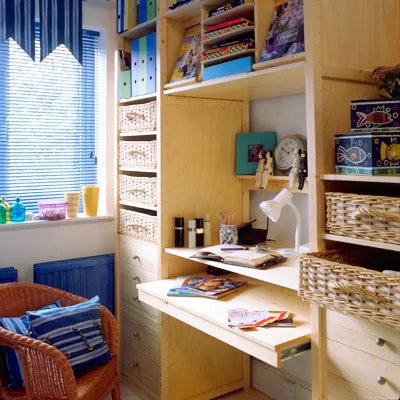
3. Creative Closet Space
Repurposing an underused closet can yield a charming and practical homework nook. Remove the closet doors and line the walls with a fun, eye-catching pattern to transform the space. Involve your child in the design process to make the area appeal to their wants. While their ideas might differ from yours, incorporating their input will make the space more inviting and encourage them to use it regularly for studying. Add personal touches such as their favorite books, a soft rug, or even a small bulletin board for photos and notes.
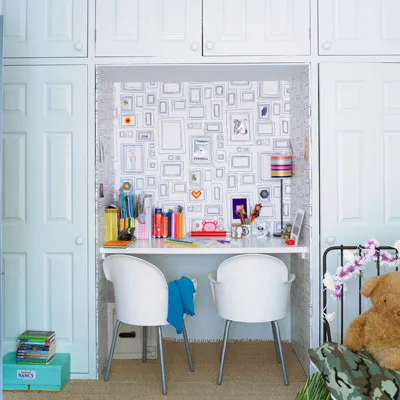
4. Armoire Office
For those seeking a versatile solution, create an armoire office. This clever design features a fold-down table that serves as a workstation when needed and can be tucked away neatly when not in use. The compact nature of an armoire office makes it great for shared spaces or rooms with limited square footage. It also helps maintain a clutter-free environment by concealing study materials when closed. Integrate cable management to keep electronic cords organized and out of sight.
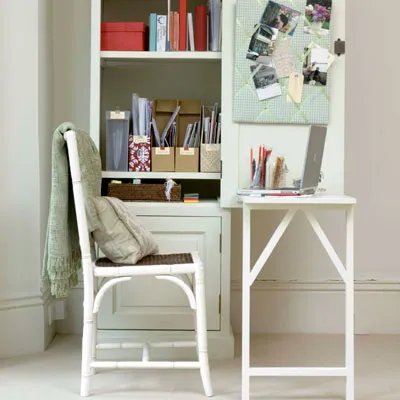
5. Cozy Corner
Sometimes, simplicity is key. A cozy corner study station can be created with minimal effort using wall-mounted shelves or cubbies and a small computer desk. This setup is perfect for children who prefer a more intimate workspace. Personalize the area with inspiring artwork, a comfortable chair, and good lighting to create an atmosphere that encourages focus and productivity. Including a small plant can add some nature, contributing to a calming environment.
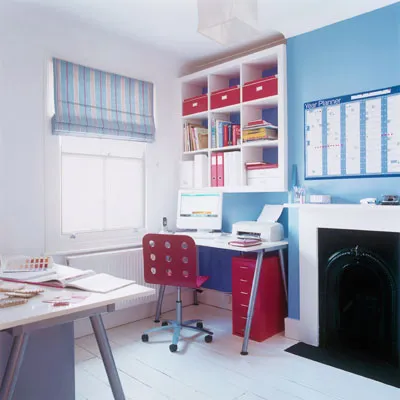
6. Corkboard Wall
Make a bold statement by covering an entire wall with cork tiles or chalkboard paint. This creates a striking visual element while providing a large surface for pinning up schedules, artwork, and reminders. The interactive nature of a corkboard or chalkboard wall can help children stay organized and engaged with their studies. Adding colorful pins and chalk adds a playful element, making the study area more appealing.
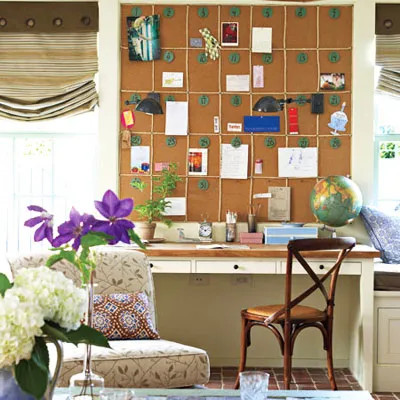
7. Kitchen Counter Homework Station
For younger children who require more supervision during homework time, a small desk at the end of a kitchen counter can be ideal. This open-yet-compact workspace allows parents to assist with assignments while preparing meals or attending to other household tasks. The proximity to the kitchen also facilitates easy snack breaks and encourages family interaction during study sessions.
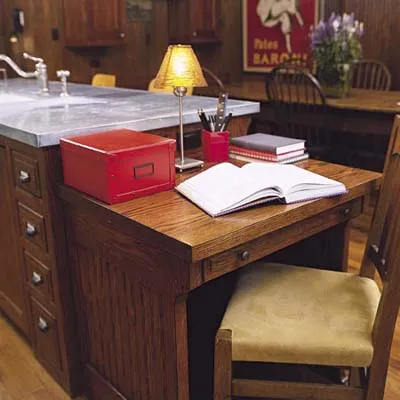

8. Plugged-In Study Nook
In today’s digital age, a well-equipped study area often requires multiple power outlets. Create a plugged-in study nook by carving out space in the kitchen or another central location. Position the desk to face a wall, minimizing distractions and promoting focus. Incorporate built-in cabinetry for ample storage of books, supplies, and electronic devices. This setup makes it so all necessary tools are within reach, streamlining the homework process. Adding a comfortable chair will make long study sessions more manageable and enjoyable.
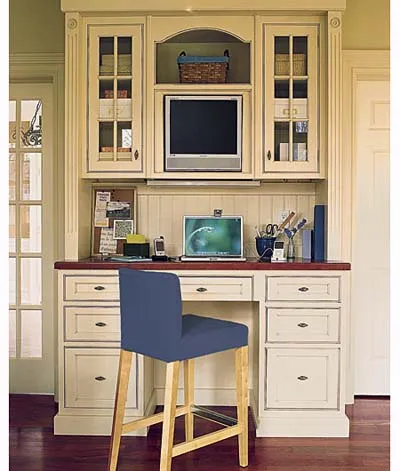
9. Great Room Homework Station
When dedicated office space is limited, integrate a homework station into your great room. Use a vacant wall to create a built-in work unit that complements the room’s overall design. This approach allows for shared use of living spaces while providing a designated area for studying. However, establish rules about television use during homework time to maintain a distraction-free environment. Be sure to add sufficient storage to keep study materials organized and out of sight when not in use.
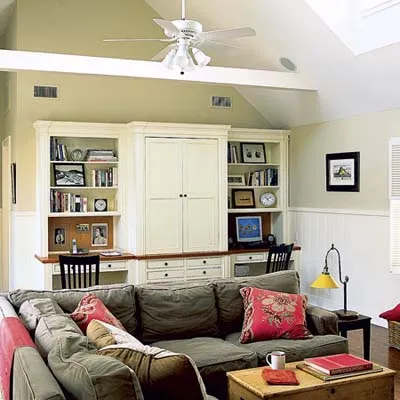
10. Light, Bright Desktop
Proper lighting reduces eye strain and maintains focus during study sessions. For sit-down kitchen desks or other homework areas, provide adequate illumination by positioning light sources. A good rule of thumb is to leave about 30 inches between the bottom of a pendant light or lampshade and the work surface. This arrangement provides ample light without creating glare or shadows on the desktop. Use LED bulbs for energy efficiency and consistent lighting.
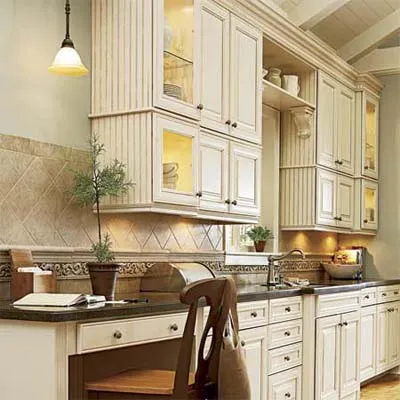
11. Budget Home Office
Creating an inspiring homework area doesn’t have to break the bank. Use leftover materials and bargain finds to design a functional and aesthetically pleasing space. Incorporate a homework nook into existing built-in storage by repurposing shelves or cabinets. This approach not only saves money but also adds character to the space. Use vintage or reclaimed items to create a unique and personalized study area that reflects your child’s interests and personality. Repurposing old furniture and DIY decor can add a personal touch and provide a sense of accomplishment.
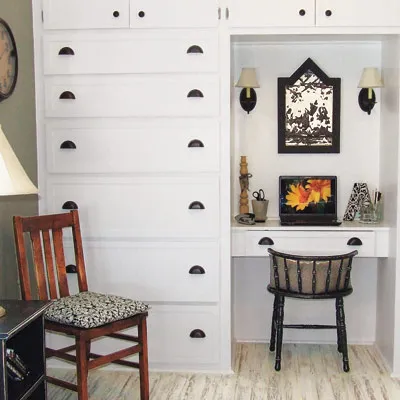
12. Rustic Reclaimed Study Station
For older children or teens, a rustic reclaimed study station can serve as both a functional workspace and a lesson in eco-friendly design. When incorporating salvaged materials, strike a balance between character and simplicity to avoid a cluttered appearance. Use reclaimed wood for desktops or shelving, and repurpose vintage items for storage or decor. This approach not only creates a unique study area but also teaches sustainability and creative reuse. Encourage your child to get involved in the design process to make it a collaborative and educational experience.
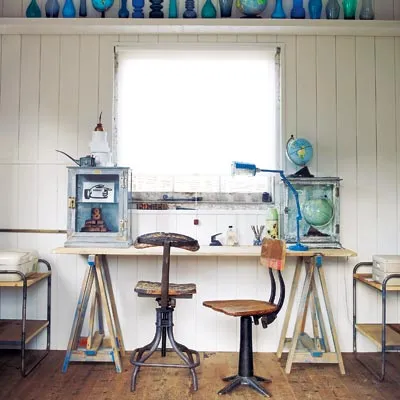
13. Side-by-Side Seating
In households with multiple children or where parents want to work alongside their kids, a side-by-side seating arrangement can be ideal. Include features such as outlets for multiple devices, task lighting, and shared storage. This setup encourages collaborative learning and allows for easy supervision when needed. Using matching chairs and coordinated decor can create a cohesive and harmonious look.
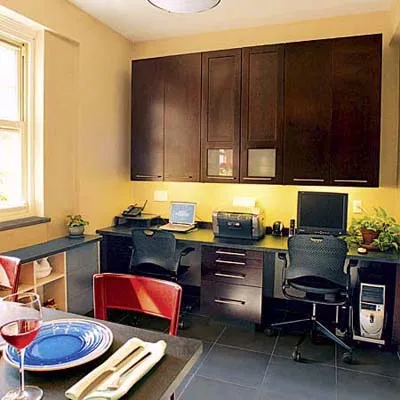
14. Creative Catch-All
A multifunctional homework station can serve as a central hub for various family needs. Incorporate elements such as a first-aid center, tech charging station, and storage for documents alongside the study area. Use a combination of open and closed storage to keep frequently used items accessible while concealing clutter. A corkboard backsplash provides a convenient spot for pinning notes, schedules, and reminders, helping to keep the entire family organized.
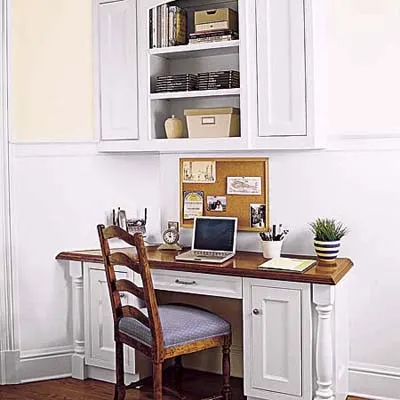
15. Space-Saving Station
For homes with limited floor space, a wall-mounted homework station can be an excellent solution. Design a unit that props up against the wall, similar to a ladder rack, with built-in shelving and a fold-down desk surface. This type of station can be anchored for stability or left portable, allowing for easy relocation if needed. The vertical design maximizes storage while minimizing the footprint, making it perfect for small bedrooms or shared living spaces. Incorporate hooks and pegs for additional hanging storage options.
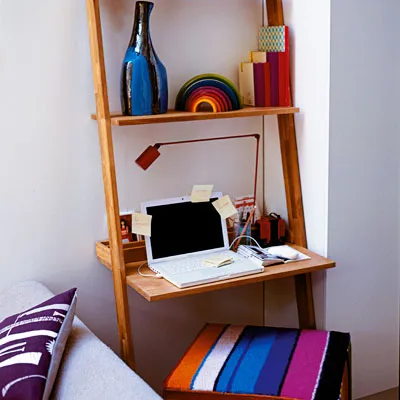
16. Modern Home Office
Create a sleek and modern homework area by incorporating floating storage units and minimalist design elements. Large, high-impact shadowboxes can serve as both decorative features and functional storage spaces. This approach keeps the floor clear, creating a sense of openness and making the room appear larger. Choose a cohesive color scheme and streamlined furniture to complete the contemporary look. Use clear containers to store supplies, maintaining a tidy and uncluttered appearance.
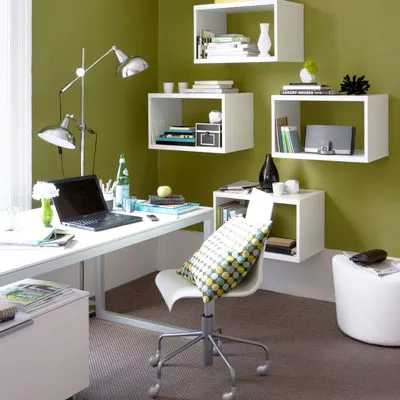
17. High Impact Work Station
Add a pop of color and personality to your child’s study area with boldly colored storage. Use vibrant boxes for organizing supplies and color-coordinated binders for filing completed assignments and papers. This makes the space visually appealing and helps children develop organizational skills by associating different colors with specific subjects or types of materials. Use magnetic containers for small items to keep them easily accessible and neatly organized.
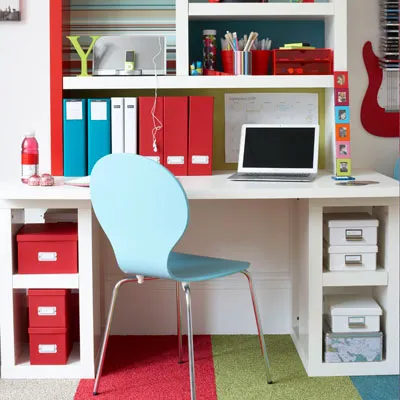
18. Hidden Study Station
In shared living spaces, a hidden study station can help maintain a clutter-free appearance when not in use. Use slim bifold doors to conceal the workspace, allowing it to blend seamlessly with the surrounding decor. This is particularly useful in living rooms, dining areas, or bedrooms where you want to maintain a cohesive aesthetic while still providing a dedicated homework space. Select furniture that matches the room’s existing style to create a harmonious look.
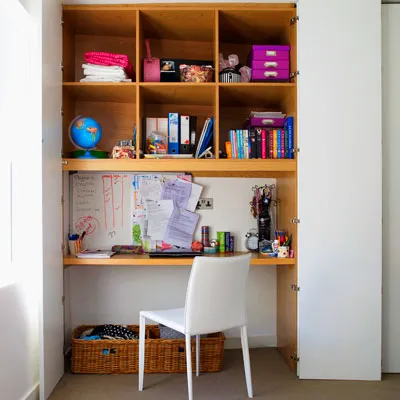
19. Wall-Mounted Wonder
Maximize vertical space with a wall-mounted folding desk that doubles as a covered storage unit. This compact solution is perfect for small rooms or areas where floor space is limited. When closed, the unit serves as a decorative wall feature, and when opened, it provides a functional workspace with built-in storage for supplies. Look for easy-to-install options that can be adjusted as your child grows. Add magnetic boards or pegboards above the desk for additional versatile storage.
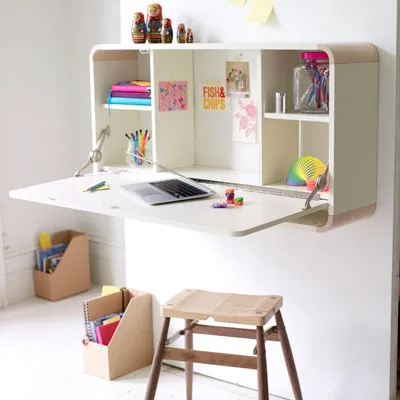
20. Adjustable Storage Station
Create a flexible homework nook using adjustable wall-mounted shelving. This cost-effective alternative to built-in storage allows you to customize the space as your child’s needs change over time. Choose a shelving system that can be easily reconfigured to accommodate different textbooks, supplies, and equipment as your child progresses through school. Integrating various storage solutions such as bins, baskets, and boxes can help keep the area organized and neat.
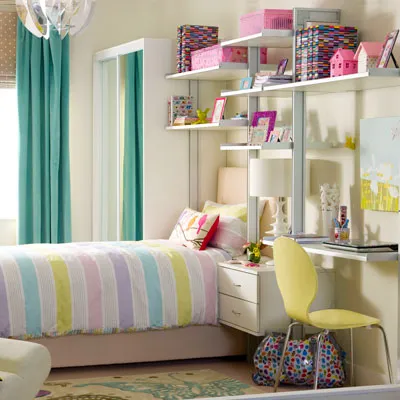
21. Catch-All Cubby Bins
Incorporate open shelving with a variety of storage bins to create a versatile and organized homework station. Choose bins in different materials and colors to add visual interest while maintaining functionality. Wicker baskets can lend a natural, organic feel, while brightly colored fabric bins can inject energy into the space. Label each bin clearly to help your child develop good organizational habits. Use transparent bins for items that are used more frequently, making them easy to locate quickly.

22. Pretty and Punctual Homework Area
Encourage time management skills by incorporating a wall-mounted clock into your child’s study area. Allow your child to personalize the space with a few carefully chosen decor items, striking a balance between functionality and self-expression. This approach helps create a sense of ownership and pride in the workspace, potentially increasing the likelihood of consistent use. Adding motivational quotes or posters can inspire and motivate your child during study sessions.

23. Walled-Off Study Station
In larger rooms, create a dedicated study area using built-in room dividers. This approach provides privacy and helps minimize distractions while maintaining an open feel. Use a combination of open shelving and solid panels to create a semi-enclosed space that can be customized to suit your child’s needs and the room’s overall design. Integrate lighting such as desk lamps or wall-mounted sconces to make sure the area is well-lit.
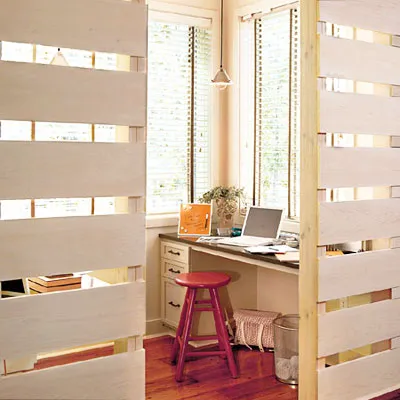
24. Work Space With a View
Position desks near windows to take advantage of natural light and provide a pleasant view during study sessions. This arrangement can help reduce eye strain and create a more inviting atmosphere. Make sure that the view is not overly distracting and use adjustable blinds or curtains to control light levels throughout the day. Add some greenery or decorative plants on the windowsill to create a refreshing and vibrant environment.
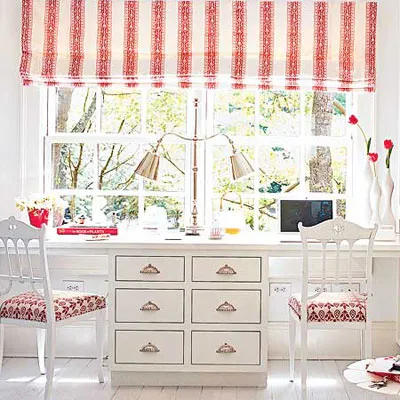
25. Kid’s Corner
Transform a small corner of your child’s bedroom into a dedicated homework station. Use corner desks or L-shaped configurations to maximize space efficiency. Add floating shelves above the desk for additional storage and display space. This setup allows your child to have a personal study area without sacrificing too much floor space in their room. Personal touches such as favorite knick-knacks and artwork can make the area more appealing and comforting.
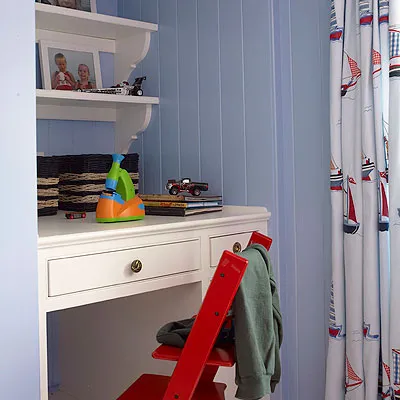
26. In-House Computer Lab
For families with multiple children, creating an in-house computer lab can provide equal access to technology for schoolwork. Make sure that each workstation has sufficient outlets for powering computers and charging devices. Design the space to accommodate different age groups and learning styles, with adjustable seating and desk heights if possible. This shared space can foster a collaborative learning environment while allowing for individual focus when needed. Include noise-canceling headphones to help minimize disturbances when several activities are happening simultaneously.
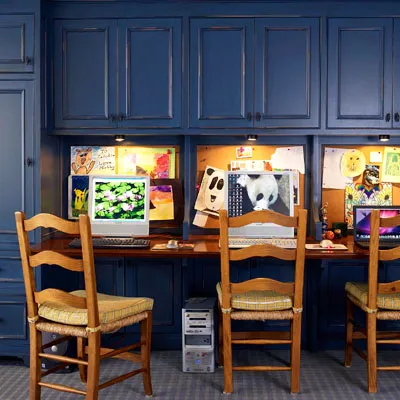
27. Reader-Created Study Station
Draw inspiration from creative homeowners who have designed unique study spaces for their children. For example, reader Carol Dregne of Galena, Illinois, created a vibrant workstation for her two boys to share. The world map wall covering serves as both an educational tool and an eye-catching backdrop. Incorporate educational elements into your child’s study area to make learning a natural part of the environment. Tailor elements such as world maps, periodic tables, or historical timelines to your child’s interests to make the space more engaging.
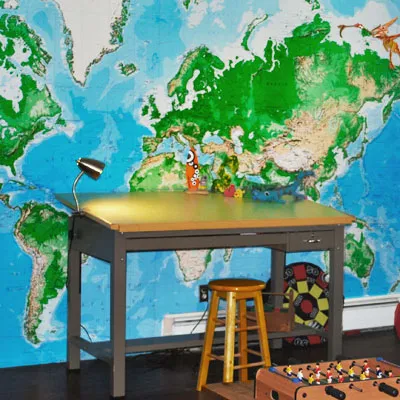
Next Up In Home Offices
- 5 Best Mouse Pads (2024 Guide)
- 5 Best L-Shaped Desks (2024 Guide)
- The 4 Best File Cabinets (2024 Review)
- The 5 Best Office Chairs (2024 Review)
- The 5 Best Fountain Pens (2023 Review)
- The 4 Best Pencil Sharpeners (2024 Review)
Get the latest This Old House news, trusted tips, tricks, and DIY Smarts projects from our experts–straight to your inbox.

IMAGES